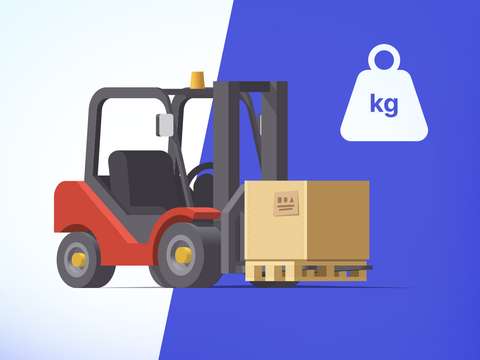Electronic products require special care during the shipping and packaging process. From the selection of packaging materials to the placement of the product, every decision can make the difference between your item arriving safely and being damaged in transit. We explain the steps you need to know to package and ship electronics safely.

Why electronic products are damaged during shipping
Before packing or shipping electronic products, you should know what the most common causes of damage are:
- Humidity: Moisture in the air can cause condensation damage inside the packaging, especially if the humidity is too high.
- Temperature: Extremes in temperature, both hot and cold, can adversely affect electronic devices during shipping. Low temperatures can compromise the integrity of hard drives and reduce battery life.
- Vibration: Vibrations during shipping, such as those generated by the engines of transport vehicles, can cause repeated shock damage to electronic devices, affecting their operation.
- Electrostatic discharge (ESD): Resulting discharge can cause damage to sensitive electronic devices, especially during transport.
- Impacts: Impacts during transportation of electronic devices can cause damage similar to that suffered by glassware or unfired clay due to the sensitivity of the components.
Related article
How to pack electronic products for shipping
Remove the removable parts
Carefully disconnect and remove any removable parts from the device, such as cables, batteries, memory cards, etc. Wrap each part individually in bubble wrap or tissue paper and place it in a Ziploc bag or small container for protection.
Pack the main device
Wrap the electronic device in several layers of bubble wrap. Be sure to cover all surfaces, including screens, corners, and edges. Use tape to secure the bubble wrap in place and prevent it from moving during shipping.
Protect the screen
If the electronic product has a delicate screen, such as a smartphone or tablet, it is essential to protect it properly. Apply a layer of clear protective film or use special screen protectors that fit the size and shape of the device.
Place the device in the box
Place the wrapped device in the center of the shipping box. Carefully fill the remaining space around the device with more packing material, making sure there are no empty spaces. Pay special attention to areas around corners and fragile edges.
Add the removable parts
Place the Ziploc bag or container containing the removable parts of the device inside the shipping box. Use additional packing material to separate the parts from each other and prevent them from moving during shipment.
Fill the shipping box
Choose a sturdy cardboard box that is large enough to accommodate the wrapped device with an additional space of at least 5 cm around all sides. Fill the bottom of the box with loose packing material, such as polystyrene peanuts, air pellets, or crumpled paper.
Close the box
Seal the shipping box with strong tape. Apply several layers of tape to the edges and flaps of the box to ensure a secure seal.
How to choose the best box for shipping electronic products
To choose the perfect box for your electronics, consider the dimensions and fragility of the product, select a sturdy carton with certifications, use a variety of filler materials to completely fill the empty space, seal and label the box securely, and consider packaging testing, shipping regulations, and sustainability.
Packaging materials for shipping fragile electronic products
Corrugated cardboard boxes
Corrugated cardboard boxes are characterised by additional strength and cushioning against knocks and drops. They are widely used for packaging and shipping electronic products.
Polystyrene foam (white cork)
Styrofoam is a lightweight, strong material that can be used to create a cushion around the electronic product inside the box. It helps absorb shock and protect against vibration.
Air bubbles
Air bags or bubble wrap are excellent for wrapping fragile electronic products before placing them in the shipping box. Air bubbles provide an additional layer of protection against shock and excessive pressure.
Kraft paper
Kraft paper can be used to wrap electronics individually or as padding inside the box to prevent them from moving during transport. It is a more eco-friendly option compared to other packaging materials.
Cardboard corner protectors
Cardboard corner protectors provide additional reinforcement at the corners of the box, where electronic products are often most vulnerable to bumps and drops.
Strong adhesive tape
Use high-quality, heavy-duty adhesive tape to seal the shipping box securely and prevent it from opening during transport.
Recommend to read
Learn how to professionally manage your eCommerce shipments.
Best practices for shipping electronic products
Add shipping labels correctly
Make sure that the shipping label contains all the information about the order and the delivery address. If the product is sensitive or requires a specific type of transport, it is essential that you also add this on the label.
Require signature on delivery
In 2021, 35.5 million Americans were victims of hacking, which means that retailers should consider signature on delivery to avoid this problem. Most major courier companies such as USPS, UPS or FedEx offer this service. Consider signing for it when packaging or shipping electronics.
Double your cushioning materials
You can double your investment in packaging if necessary to ensure that electronics shipped are not damaged. Many of these materials can be cheaper than pre-conditioning or handling returns.
Use shipping insurance
It is highly recommended to use shipping insurance when shipping sensitive or high-value electronic products. Shipping insurance will protect you against loss, theft or damage due to mishandling by the carrier.
Split the shipment
There are cases where you might have an electronic product available to ship, but not its accessories. You can split the order and ship the available item first to reduce the wait time for your customer.
Send tracking notifications
Sending shipping notifications will keep your customers informed about the whereabouts of their purchase. These notifications provide peace of mind during the delivery phase, enhancing the shipping experience. Additionally, with specialized eCommerce shipping software, you can promote other items and execute cross-marketing strategies to boost sales.
How to choose a carrier for shipping electronic
It is essential to choose a carrier that has experience in handling and shipping electronics. Some carriers offer specialized packaging services for electronics. Also, check to see if the carrier offers insurance options to protect your goods in case of damage or loss. Compare delivery times and costs of different carriers to ensure you get the best value for your money.
Carriers for shipping electronics internationally
- DHL: A global leader with extensive experience in shipping electronics, DHL offers specialized packaging services, insurance, fast delivery times, and worldwide coverage.
- FedEx: Another popular choice for international electronics shipping, FedEx provides similar services to DHL, including specialized packaging, insurance, and tracking.
- UPS: While UPS excels for international electronics shipments within North America and Europe, it also offers fast delivery times, coverage in a wide range of countries, and insurance options.
Carriers for shipping electronics within the USA
- Lasership: Lasership is another ground carrier that offers economical services for domestic electronics shipments within the USA.
- USPS: is an economical and reliable option for domestic electronics shipping within the USA. They offer different shipping services, including Priority Mail and Priority Mail Express, which offer fast delivery times and tracking.
- Echo Global Logistics: Echo Global Logistics is another US-based logistics company that offers domestic and international transportation services, including electronics shipping. They are known for their innovative technology and focus on customized solutions.
FAQ
How long does it take to ship electronics?
It depends on how far your package travels. In general, within the same country, it takes between 1 and 5 business days. For international destinations, expect 3 to 10 business days, although sometimes it can take longer.
How much does it cost to ship electronics?
The price depends on the journey, size, and weight of your package, as well as the shipping service you choose. International shipments are generally more expensive than domestic shipments. In general, you can expect to pay between $5 and $50 for domestic shipments and between $25 and $200 for international shipments.
Conclusion
Product damage can cause serious losses to your profit margin. Applying the techniques in this article will allow you to package and ship electronic products safely. Additionally, a good shipping strategy is key to building customer loyalty and increasing repeat sales. Work on providing a good shipping experience to differentiate yourself from your competition and ensure maximum buyer satisfaction.




